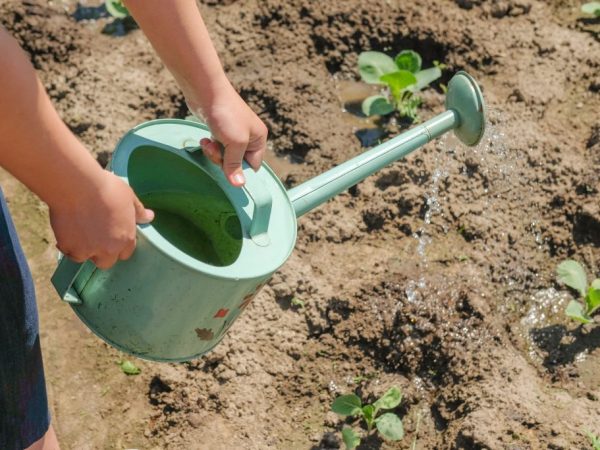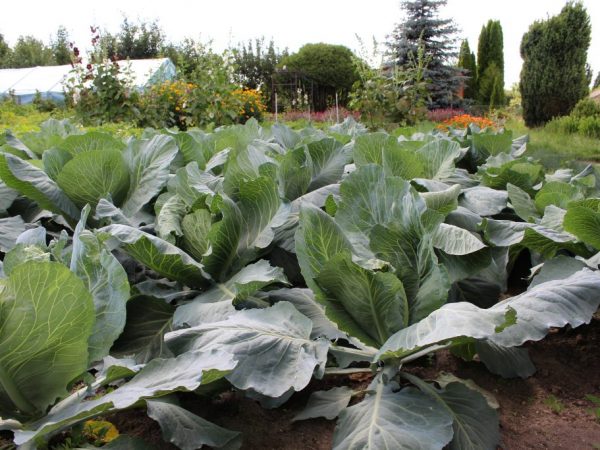Effective fertilizer for cabbage
To get a high yield, cabbage fertilizers should be applied regularly, observing the proportions and periods of feeding.

Effective fertilizer for cabbage
Nitrogen fertilizers
If the cabbage leaves begin to turn yellow, dry up and fall off, and the head of cabbage stops growing, then the vegetable is deficient in nitrogen. To satisfy the need, use:
| Name | Description |
| Ammonium nitrate | It is one of the concentrated nitrogen fertilizers. It has an off-white color of crystals and about 35% of available nitrogen for plants. Apply the product strictly according to the instructions. Excessive amounts contribute to the accumulation of nitrates in the stem and leaves. |
| Ammonium sulfate | White crystals of sulfuric acid contain 20-22% of nitrogen available to plants. The composition contains sulfur. Do not overdo it, since acidification of the soil is not always desirable. |
| Urea | Transparent white crystals of ammonium salt of carbonic acid. Contains; 47% nitrogen. |
Too much nitrogen is very harmful to the plant, so it is worth applying fertilizers in the amount indicated on the preparations.
Potash fertilizers
For cabbage, it is important to introduce preparations containing potassium. It helps distribute organic matter throughout the plant. It is necessary for the proper formation of the root system and the head of cabbage.
With a lack of potassium, the leaves become:
- lumpy, corrugated at the edges;
- lighter than usual color;
- less elastic and dry out.
When these signs appear, potassium nitrate for cabbage should be added.
One of these dressings is potassium chloride. It has a sufficient share - 62% of the norm required for the plant. Keep in mind that it strongly acidifies the soil.
It contains 49% potassium. Potassium chloride is used in the form of dressings. It is recommended to sprinkle it into the soil with other preparations.
Phosphate fertilizing
Cabbage does not need a lot of phosphorus, but its introduction is extremely useful for the proper formation of the vegetable. Superphosphate is a good top dressing. It contains up to 20% of the phosphorus available to plants. It should be taken into account that phosphorus is poorly absorbed when introduced into acidic soils.
With a lack of phosphorus, the leaves begin to darken, acquiring an emerald hue. The edges are covered with a burgundy-purple color, the ovaries of the heads of cabbage take much longer than usual.
Calcium fertilizers

Fertilizers will increase the immunity of cabbage
Calcium nitrate is used for feeding. Calcium nitrate is composed of 20% calcium and 12% nitrogen. Oxidation of soils with calcium nitrate is insignificant.
You can find out about the lack of calcium by looking at the white spots on the leaves. Timely application of calcium nitrate and cabbage will ensure the full growth of the culture.
Calcium nitrate is a cabbage lifesaver. Due to it, an optimal nutrient medium is formed for the development of a vegetable and protects against various ailments.
Calcium nitrate is used to feed seedlings, and when planting, fertilizer is applied to the hole in 1 tsp and sprinkled with earth.
Organic
Organic fertilizing - compost, manure, humus and ash - is good to introduce into the soil at the beginning of autumn. A layer of perennial grasses is also a good saver for cabbage for the winter. Fertilizers are applied to the soil before loosening or directly into the hole during transplantation.
Application methods
At each certain period of growth, cabbage requires a special type of feeding. The quality of the crop depends on the correct fertilization.
Top dressing of seedlings
| Composition | Application time and quantity | Proportion |
| Potassium chloride, ammonium nitrate, superphosphate | 10-15 days after the dive process. Apply at the rate of half a glass per plant | Dilute 15 g of potassium chloride, 30 g of ammonium nitrate and 35 g of superphosphate in 10 liters of water |
| Ammonium nitrate | 14 days after the first feeding. Spill 2/3 cup of each plant. | 30 g of ammonium nitrate per 7 liters of water |
| Potassium chloride, ammonium nitrate, superphosphate | 3-5 days before disembarkation. Based on a glass per plant. | 20 g of potassium chloride, 35 g of ammonium nitrate and 60 g of superphosphate per 10 liters of water |
With poor growth, seedlings should be sprayed with a solution of Nitrofoski 15 g per 5 liters of water.
Landing in open ground
When planting in open ground, the following fertilizers are used:
| Composition | Proportion |
| Humus or compost, superphosphate or nitrophoska, and wood ash | 600 g of humus, 40 g of ash and 20 g of superphosphate or 15 g of nitrophosphate, mix, sprinkle earth from the hole. |
| Humus and wood ash | Mix 150 g –200 g of humus with 3 tbsp. l. wood ash. |
| Potassium preparations | According to the instructions. |
When planting, fertilizers are applied in portions to each well.
For active growth

Top dressing stimulates plant growth
This type of feeding is carried out 15-18 days after the seedlings are planted in open ground. To do this, use:
| Composition | Proportion per 10 l of liquid |
| Manure or bird droppings | 80-100g |
| Urea | 15g |
| Ammonium nitrate | 17–20g |
| Superphosphate and ash | 100g of ash or tobacco and 2 tbsp. l superphosphate |
| Superphosphate, urea and potassium chloride | 15 g urea, 15 g potassium chloride and 25 g superphosphate |
| Mineral complex based on potassium humate | 30 g mixture |
In wet weather, phosphorus, nitrogen and potassium or mineral complexes are scattered from above the beds and dug up. The amount of top dressing should be taken at 150 g each or 500 g complex for a plot area of 5 m².
To form a head of cabbage
When the ovaries begin to appear, it is worth adding another top dressing. To do this, you can apply the following methods:
| Composition | Quantity per 10 l of liquid |
| Manure or bird droppings | A solution with 1 kg of manure and 800 g of droppings, previously filled with boiling water and aged for about a week. |
| Wood ash | 200 g of ash to insist on 1 liter of boiling water |
| Bird droppings and wood ash solution | 500 g of droppings and infused ash (filled with boiling water, should be infused for 5 days). |
| Dung or cow dung, Azofoska and mineral complexes | 500 g –600 g of cattle manure or bird droppings, 35 g of Azofoski and 20 g of mineral fertilizers |
| Nitrofoska | 50g. |
Good for Agricola cabbage. It speeds up the growth of the vegetable and increases the yield by 20%. It is diluted in water 25 g per 10 liters of liquid. This volume is enough for a plot of 10-15 m².
Pest drugs
Cabbage is a crop that is not recommended to be treated with chemicals to protect it from pests. The dense head of cabbage does not allow washing away the remnants of the preparations.
To save from pests, biological preparations are used:
| A drug | Pests |
| Bitoxibacillin and Bicol | Aphids, bugs |
| Aktofit | Gnawing pests |
| Pecilomycin | Nematodes |
| Nemabakt and Antonem-F | Cabbage fly, beetle larvae, locusts. |
| Verticillin | White wing, aphid |
Insecto-fungo-stimulant Cabbage rescuer is a complex agent that prevents pests from destroying the crop. The growth stimulator ensures the full development of culture.
Conclusion
Compliance with the proportions of fertilizers will help get rid of drying and decay. Correct treatment with drugs from pests and adherence to the feeding process will help increase the yield of cabbage.


